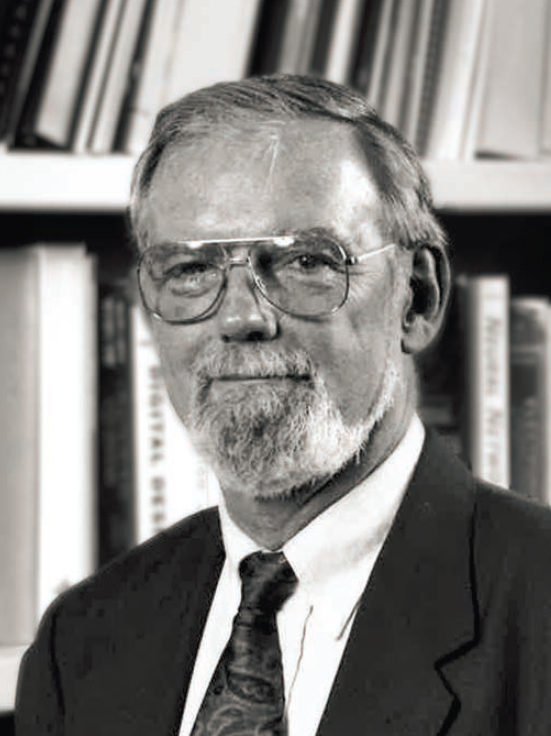
JAMES S. THORP
1937–2018
Elected in 1996
“For contributions to the development of digital techniques for power system protection, monitoring, and control.”
JAMES SHELBY THORP passed away May 2, 2018, in Blacksburg, Virginia. He was the Hugh P. and Ethel C. Kelly Professor Emeritus of Electrical and Computer Engineering in the College of Engineering and had been head of the EECE Department at Virginia Tech (2004–09). He was 81.
He was born February 7, 1937, in Kansas City, Missouri. After high school he attended Cornell University, from which he received his bachelor’s, master’s, and PhD degrees in electrical engineering. He stayed at Cornell as a faculty member and eventually director of the School of Electrical Engineering, where his tenure saw the development of an advanced program in all branches of the discipline as well as the hiring of faculty well recognized for their contributions to various fields of electrical engineering. The contributions of his graduate students and colleagues attest to the training they received at Cornell.
Professor Thorp was a close colleague and collaborator of mine for the past 40 years. Together we produced papers and books in the field of computer relaying and wide area measurements using phasor measurement units (PMUs).
We started working together at the American Electric Power Service Corporation in New York City when Jim joined AEP on a sabbatical leave from Cornell in 1976. Very soon he
began making highly original contributions, such as his work on the limitation on speed of protection devices induced by noise in the signals available to the protection tasks. His work in this area is well recognized in the industry and guided our research at AEP as it was immediately clear to all who worked with him that here was a person who could provide a sound technical basis for the work going on at AEP.
He contributed to developments at the national and international levels by participating in relevant activities of the Institute of Electrical and Electronics Engineers (IEEE) and International Council for Large Electric Systems (CIGRE). These organizations were heavily involved in conducting frontline research in all aspects of computer applications in power systems.
Also at this time Jim and his students began a collaboration with faculty and students at Virginia Tech. He was a principal contributor to the development of PMUs there, and they have been recognized by electric utility industries around the world as the modern measurement system capable of providing advanced control, monitoring, and protection of power grids. Virginia Tech’s ECE Department was very fortunate to have him as head while he continued his research with the VT power engineering team.
Prof. Thorp published books and hundreds of papers and articles and was an engineering superstar, outstanding teacher (who won many teaching awards), and gifted administrator. His contributions were recognized with various honors over the years. He became an IEEE fellow in 1989, and was elected to the NAE in 1996. He was selected for the 2001 Power Engineering Society Career Service Award and the 2006 IEEE Outstanding Power Engineering Educator Award, and in 2008 he and I jointly received the Franklin Medal in Electrical Engineering.
In May 2013 he was honored by a 2-day symposium organized by Dominion Virginia Power Company at which many scholars, research faculty, and private-sector professionals presented papers illustrating the impact of his research on their work (I was humbled to be honored with him at the same
symposium). One of his graduate students confessed that she had never thrown out any piece of paper that Prof. Thorp wrote on, as she was certain he was the most intelligent person she would ever meet.
In addition to being a brilliant academic Jim Thorp was a talented artist, woodworker, lover of opera, and avid golfer. Anything he was interested in he would study and master with ease.
He also had a great sense of humor and entertained everyone with his anecdotes and jokes. His life experiences gave him a wealth of stories that sounded improbable but in fact were true. His most famous episodes concerned his time in the New York−New Jersey area, including an experience involving theft of a car battery and spare tires (a story repeated so many times that many of his friends can repeat it). He commanded the attention of anyone in his presence and did so until the day he died.
To his students and colleagues he was a great mentor who made them better professionals and better people. He never judged people based on their race, religion, sexual orientation, or for any other reason. He also had a great respect for women, especially women engineers, and helped many during his lifetime.
Prof. Thorp was married three times: first to Barbara (née Curit), who supported his early career, then Christine (née Moore), and then Jane Haw Dusanic, whom he had met in high school and married in 2013. Jane cared for him lovingly and unselfishly during the last years of his life. She passed away in her sleep on February 23, 2021. Jim is survived by daughter Betsy VanAlstyne (William), son Gregory Thorp, stepdaughter Erica Shoemaker (David), and three grandchildren; he was predeceased by his son Jeffrey Thorp.
Jim Thorp is missed by many people in the electric power industry, to which he contributed so many brilliant ideas, and by his many students, colleagues, and those of us who participated with him in a most exciting period in the field of electric power engineering.




